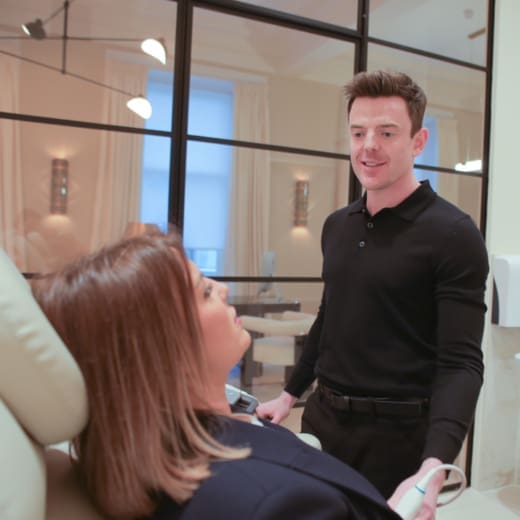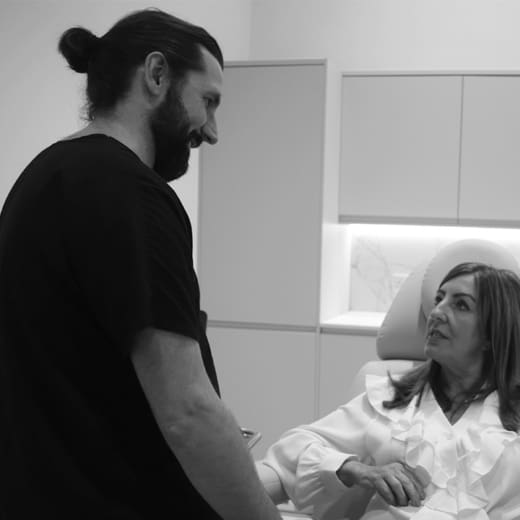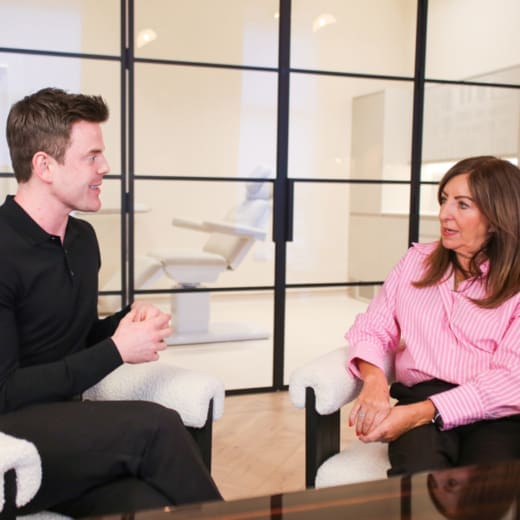McKeown Medical
167 Bath Street, Glasgow, G2 4SQ
Date posted — 21.10.24
The eyes are often described as the window to the soul. They are also often one of the first parts of the face to show signs of ageing, conferring a tired or worried look. It’s little wonder, therefore, that there is a lot of interest in treatments that help to reduce signs of ageing around the eyes.
One of the most common signs of ageing around the eyes is wrinkles at the sides of the eyes, known colloquially as ‘crow feet‘ or more technically as ‘lateral canthal rhytids’. These lines are usually caused by repetitive movement of the underlying orbicularis oculi muscle. Treating these lines using anti-wrinkle injections, which act to reduce the underlying muscle activity, is, therefore, one of the most popular treatments for eye wrinkles.
It is derived from a bacterium called Clostridium botulinum. Contrary to popular opinion, you are not being injected with harmful bacteria. Nor are you even being injected with a full toxin – the drug is simply derived from the toxin produced by the bacteria, similar to the way many other types of drugs are manufactured.
When injected in small doses, the drug blocks the nerve endings from stimulating the muscles to contract – causing the muscle to relax, usually for a few months at a time.
The anti-wrinkle procedure is relatively straightforward. It involves injecting small amounts of diluted drug into targeted facial muscles. In order to achieve the best results, you should make sure you are treated by an experienced doctor who intuitively understands the balance of anatomy, physiology and pharmacology to allow them to tailor the advice and treatment to your own unique circumstances to achieve the best results.
You can usually start to see the results of the treatment within a few days, although it typically takes up to two weeks to see the full results.
Before your anti-wrinkle treatment, it’s important that your doctor takes a full medical history, including what medications you take, any allergies you may have and how you have reacted to previous cosmetic procedures. By having a detailed understanding of your background, your doctor can make the most appropriate recommendations to ensure you achieve optimal results.
After the treatment, it is quite normal to see some immediate redness and swelling at the injection site. This normally resolves within a few minutes – typically by the time you get back to the car. It is much less common to develop any bruising. If this happens, it can usually be camouflaged with some make-up and will go away like any normal bruise.
It is quite common to develop a headache following treatment – this can affect up to 1 in 10 patients. If you develop a headache, you can take over-the-counter pain medication like paracetamol (or Tylenol if you are in the US).
Much less commonly, you can develop drooping of the eyelid or eyebrow. This usually affects around 1 in 3000 patients and is usually associated with the treatment of the frown muscles. If you are only being treated with anti-wrinkle injections around the eyes, then you should be safe from this side effect.
Crow’s feet and frown lines often occur together, along with drooping of the brow and eyelids. It is common to combine the treatment of wrinkles around the eyes with the treatment of frown lines in the same session. By employing this combination approach, it is possible to achieve a subtle brow lift, which many patients benefit from.
It’s crucial to have realistic expectations about the results of anti-wrinkle treatments. Whilst it is usually possible to reduce the appearance of lines and wrinkles, no one can guarantee that you will necessarily look any younger. Most people find that they look the same, just a little more rested.
Repeat treatments are necessary to maintain the results. The effects of each session typically last between three to six months.
The success of any cosmetic treatment largely depends on the skill and experience of the doctor performing the procedure. Make sure you always see an experienced doctor, not just for the technical aspects of performing the procedure – but for the right advice on which treatment is the best one for your needs. Practising medicine involves both art and science, which always improves with experience, so make sure you get the best advice possible for your own circumstances.

When it comes to your health, few things are more important than taking care of your gynaecological wellbeing. Yet many...

Varicose veins are more common in women than men. While many people associate these bulging, twisted veins with ageing or...

When you're trying to conceive, it's natural to focus on your ovulation cycles, hormone levels, and lifestyle habits. However, one...
1 / 3
2 / 3
3 / 3

When it comes to your health, few things are more important than taking care of your gynaecological wellbeing. Yet many...

Varicose veins are more common in women than men. While many people associate these bulging, twisted veins with ageing or...

When you're trying to conceive, it's natural to focus on your ovulation cycles, hormone levels, and lifestyle habits. However, one...
Laser rejuvenation of the eye area can be an incredibly powerful tool for the right patients, especially those whose ‘bags’ are more about loose skin and fine lines, like this lovely patient here.
We treated her with full field ablation, which takes around 2 weeks to recover from. Her she is a few weeks later and you can see how much tighter the skin is, the crepey skin has gone and the fine lines have been ironed out. The patient is over the moon.
What do you think?

Eyelid surgery is one of the most popular procedures we do in the clinic. It’s a great fix for hooded eyes! Excess skin on the upper eyelids can not only create a hooded, heavy appearance but often affects the vision too.
Here’s the very talented @bramhallplasticsurgery discussing how upper eyelid surgery (blepharoplasty) can restore a more open, refreshed look by removing the excess skin and subtly redefining the natural eyelid crease. Scars are hidden within the fold of the eyelid, leaving eyes that look brighter, not “done.”
Do you have any questions about surgery? Ask in the comments or send us a message!

Thank you to our patient for allowing us to share her before and after photos of her upper blepharoplasty.
Excess skin on the upper eyelids can make the eyes appear tired or heavy. This simple procedure restores a lighter, more open look while keeping the result completely natural.
Another fabulous result from the very talented @bramhallplasticsurgery!
What do you think?

We’ve been in our new home for a year now and I thought this would be a good time to remind you just how special it is with a little video tour.
It’s been a remarkable year for us in our new home; we’ve introduced new doctors, new treatments, new services and our team continues to grow from strength to strength - always striving to provide more and better for our wonderful patients.
Enjoy the tour!

About last night… It was time once again for our annual Christmas celebration with this absolute bunch of legends. We were a little earlier than usual this year so we could have has many people available as possible, and the evening did not disappoint.
A few sore heads this morning, but absolutely worth it to celebrate the hard work this team dedicate to our patients day in, day out all year round. I am very proud to have the undisputed best team on the planet. Merry Christmas everyone! 🎄

Fine lines etched into the skin around the mouth - this is a common problem and in this patient`s case she had what we call ‘actinic elastosis’, whereby abnormal bands of elastin build up in the skin as a result of years of previous sun exposure.
When patients have this condition, the gold standard way of dealing with it is fully ablative laser resurfacing. It’s an intense treatment with two weeks of downtime afterwards, but the results are spectacular - just like in this lovely patient.
The after photo is three weeks after the treatment and you can see that the skin is still a little pink, which will continue to fade over the next few months.
The patient is already delighted with the result - what do you think?

It’s beginning to look a lot like Christmas!
At least according to Michael Buble, who’s been on repeat in the clinic this week. The decorations are up and we are officially in ‘our season’. The clinic has been packed with everyone having their skin polished in time to make it on the nice list. If you’ve still to make a pre-Christmas appointment, we’ve still got some spaces left for your festive glow up.
Ho ho ho everyone… It’s time for Santa!!!! 🎅🏻

Ok, so this is the one we’ve all been waiting for. Sofwave : the results, in our hands!!!
This is the first patient we treated with @sofwave.uk when we were assessing the machine and deciding whether or not to buy it. These are the patient`s own photos that she kept throughout the healing journey.
Now do you see why we are so excited?! 🤩
#sofwave
#sofwavemed
#SUPERB
#sofwavemedical
#sofwavejourney
#sofwaveexperience

We are now well up and running with @sofwave.uk , much to the excitement of the whole team in the clinic (we are all queuing up to get a shot!)
This is a little video of the treatment being performed, so you can see what the process is like and there is even a little early preview of the results at the end.
One of the best parts is that there is no downtime, so we can still fit it in before Christmas without worrying about redness in the party season!
What do you think?
#sofwave
#sofwavemed
#SUPERB
#sofwavemedical
#sofwavejourney
#sofwaveexperience
